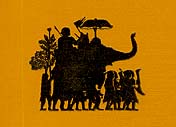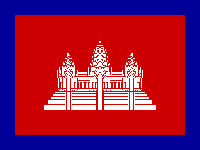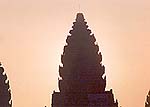


Photographs by Willard Van De Bogart
Click on all images for larger views
Section 5: Politics - Kings to Commoners
Cambodia is the only country in the world that displays a temple ruin on its national flag. That ruin is Angkor Wat the seat of the ancient Angkorean kingdom. Before Angkor it was called Yashodharapura (Glory Bearing City) established by the Cambodian Monarch Yasovarman I. It was Yasovarman who began construction on Preah Vihear, and today as King Norodom Sihanouk quietly recedes from all public exposure to die in peace the question arises who will be appointed the next king to oversee Cambodia's future, and speak out in behalf of its ancient heritage. If King Sihanouk is Cambodia's last King will the ambitious ex-Khmer Rouge fighter Hun Sen, now Cambodia's Prime Minister, be more interested in building casinos at the base of Preah Vihear or will he assist Sok An and keep the sanctity of Preah Vihear closed to hawkers and commercial tourist enterprises for at least a radius of 20 miles?
What began for me as a pilgrimage to a sacred site of the Khmers ultimately became a clarion call to wake up all spiritual pilgrims to make their voices heard so the thousands who want to make a sacred journey to Preah Vihear can do so and not be subjugated to the all pervasive belief that capitalism and profit making deserve an equal place of expression next to sacred grounds. In my opinion sacred spaces should be kept free from profit making motives and this belief should be defended in order to allow ancient sanctuaries to become the devotional spaces for which they were intended.
If Thailand has become a "Monetocracy" as Dr. Prawase Wasi decries as "fast food policies" run by Prime Minister Thaksin Shinawatra's Thai Rak Thai party then it is self evident that there will be no ruling parties who will protect Preah Vihear from commercial development on the Thai border. If Hun Sen sees casinos and resorts as the only answer to bolster his economy its unlikely any one in Cambodia who could prevent the casino near the Chong Sa-ngarm border check point in Si Sa Ket province will do so. Cambodia' decision to turn the grave site of the infamous Khmer Rouge leader Pol Pot into a resort with hotels, casinos and a duty free shop deep in the mountains of Anlong Veng is completely insane, and an insult to all the Khmers in Cambodia and around the world who lost their families with Pol Pot's pogroms for a better Cambodia during his 1975-1979 control of the country side.
Eco-Tourism, Sustainable Tourism, and Spiritual Tourism are all concepts to get the greatest amount of people to spend money under the guise of politically, environmentally, and now spiritually correct language. The situation has become a critical concern not only for the preservation of what is left of Preah Vihear but ancient sanctuaries world wide. Luang Prabang in central Laos has become victim to market penetration of all sorts of Western businesses and is now called the "lost paradise". National Geographic published a survey of 200 specialists in sustainable tourism in its March 2004 issue and Angkor Wat ranked on the bottom of the list.
The future of temple preservation in SE Asia has to be one of humanities most important concerns for the integrity of each countries spiritual history or else these abodes to the gods will become one of humanities most devastating architectural legacies. From the looting of monasteries in Nepal, to the black market of Burmese Buddha statuary, and to the pillage and plundering of the temples in Cambodia coupled with the lucrative trading of ancient artifacts all speak to an overly zealous attempt to remove sacred objects from all these countries so that they may become cherished collectibles adorning private homes and especially Asian art museums around the world.
One museum in particular which has specialized in Khmer art works is Musee Guimet in Paris. Some of the best examples of Khmer artisans work originating from the monarchical periods sits in newly open lite galleries very far removed from the temples in Cambodia. The French, with their colonial objectives in Indo-China in the late 19th century and early 20th century, removed unabated thousands of works of art from the temples of Cambodia. Ironically France's first Minister of Cultural Affairs under President Charles de Gaulle was Andre Malraux who was caught trying to steal stones from the very famous Banteay Srei temple not to far distant from Angkor Wat in 1923.
It can be argued that if this exodus of Khmer statuary by the French did not occur then there would be little left for people of today to witness the cultural legacy of the Khmers. On the other hand what remains in Cambodia today is an empty shell compared to what it must of looked like to Henri Mouhot, the French naturalist in 1850, who is attributed to announcing the discovery of the Khmer temples to the modern day world. This issue of artifact removal for museums seems closely related to the open market of buying and selling Khmer artifacts albeit with a different set of motives. Sotheby's auction house in London comes right to the point by stating, "There has been an active secondary trade in Khmer art since the French occupation in the 19th century. Standing figures from about 19 inches onward fetch around $30,000 to $50,000 on the moderate end and figures around 40 inches plus fetch prices in the $50,000 to $100,000 range". Collectors World, an organization dedicated to collecting antiquities, are so convinced in the merits of their profit making motives with rare and hard to find Khmer works of art that they feel that, "collecting Khmer sculpture is not only a passion for objects of beauty, but an act of preservation of our global cultural heritage". This has to be the most convoluted reasoning I have ever read supporting capitalism at the expense of spiritual antiquities which belong to the temples and not to the collector.
The demoralization of Cambodia from Pol Pot's legacy coupled with existing poverty and non-existent social services for the majority of the people has made basic survival so difficult that removing a temple artifact to barter for money has become a way of life. The situation is so alarming that it is essential that Thailand's foreign minister and Cambodia's senior minister really do resolve any disagreements regarding Preah Vihear which can be based on trust and mutual benefit. The ministers must also handle and problems occurring from environmental pollution and vendors shops so there can return some semblance of sanctity to this mountain temple.
If King Norodom Sihanouk could hear these pleas perhaps one last royal decree could be ushered to tell his people to preserve all the ancient monuments and prevent anyone from removing one temple stone from the country. A difficult request to be sure, but how else can these temples be monitored. However, if the King is capable of doing this then his son Prince Norodom Ranariddh, who is now sharing power with Prime Minister Hun Sen, could make a plea to the Cambodian parliament and ultimately to the people as a way of protecting Cambodia's most remarkable history.
The legacy of spirituality for the human race is to recognize that mankind has always acknowledged a higher ordering principle in the universe which has always been given divine recognition. The earthly realm of capitalism and now globalization has become sacrosanct causing spiritualism to be of lesser importance or even as an aspiration that deserves reverence and humility. Preah Vihear needs to be protected so all future pilgrims do not have to be interrupted by the myriad of forms of "spiritual tourism" while they are seeking solemnity and sanctuary on this mountain top dedicated to the gods. The Bhavalai is sacred grounds which deserves it's heritage to be preserved and honored as the place where the Khmer Kings took pilgrimage to pay respect to their gods along with countless other scholars, and common people from many other countries. The preservation of the temple is a preservation of spiritualism which still exists on these sacred grounds. The "Neak Ta" will always be at Preah Vihear and it must be the wisdom of us in the 21st century to recognize those spirits and act accordingly in helping to preserve this sanctuary that was honored and is still serving pilgrims from around the world. It is our duty to our humanness to find a way to help preserve these temples to the stars.

 Section 1: Pilgrimage - Getting there
Section 1: Pilgrimage - Getting there
 Section 2: Arrival - Photo Galleries
Section 2: Arrival - Photo Galleries
 Section 3: Bhavalai - Another time
Section 3: Bhavalai - Another time
 Section 4: Antiquities - Capitalism and Spiritualism
Section 4: Antiquities - Capitalism and Spiritualism
 "Preah Vihear: An Introdiction to the World Heritage Monument" by Sachchidanand Sahai
"Preah Vihear: An Introdiction to the World Heritage Monument" by Sachchidanand Sahai
Other stories related to the Khmer Empire.
 |
|  |
| 
Part I- Stones in the Sky - Before the Journey to Angkor Wat
Part II - Stones in the Sky - Journey to Angkor Wat - July 2002.
Part III - Stones in the Sky - Section I - Journey to Angkor Wat - March 2003.
Part III - Stones in the Sky - Section II - Journey to Angkor Wat - March 2003.
Part V - Stones in the Sky - Journey to Beng Mealea - October 2004.
Apsaras and Devatas - Photo documentation of female divinities at Angkor Wat.
Related links:
Preah Vihear Disputes 2008 - Nation Newspaper Thailand Reports - World Heritage Listing goes to Cambodia
Heritage Watch - Dr. Doug O'Reilly, Director
History of Science, Vedic Studies, Astronomy - By Subhash Kak